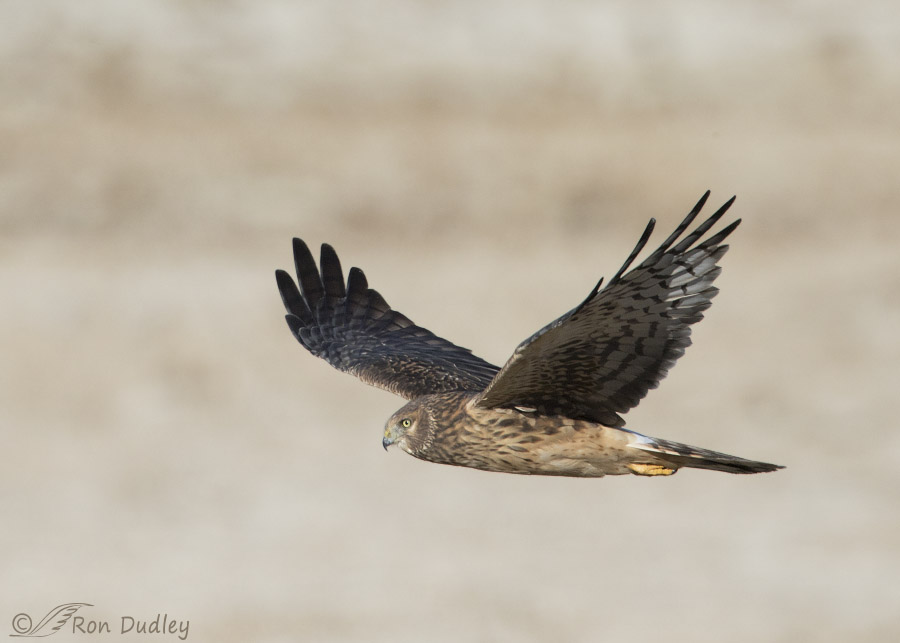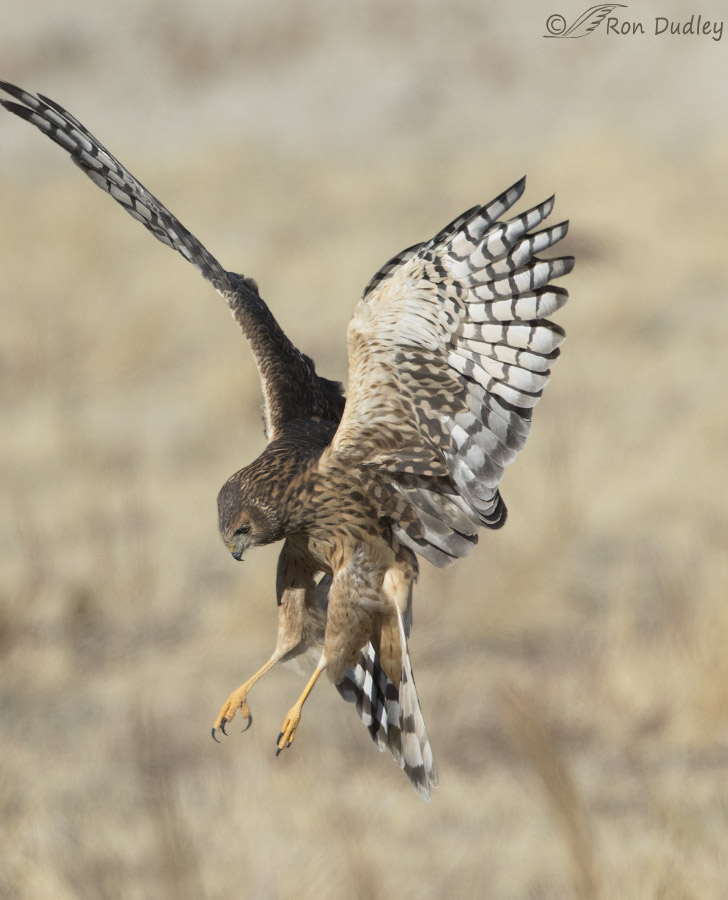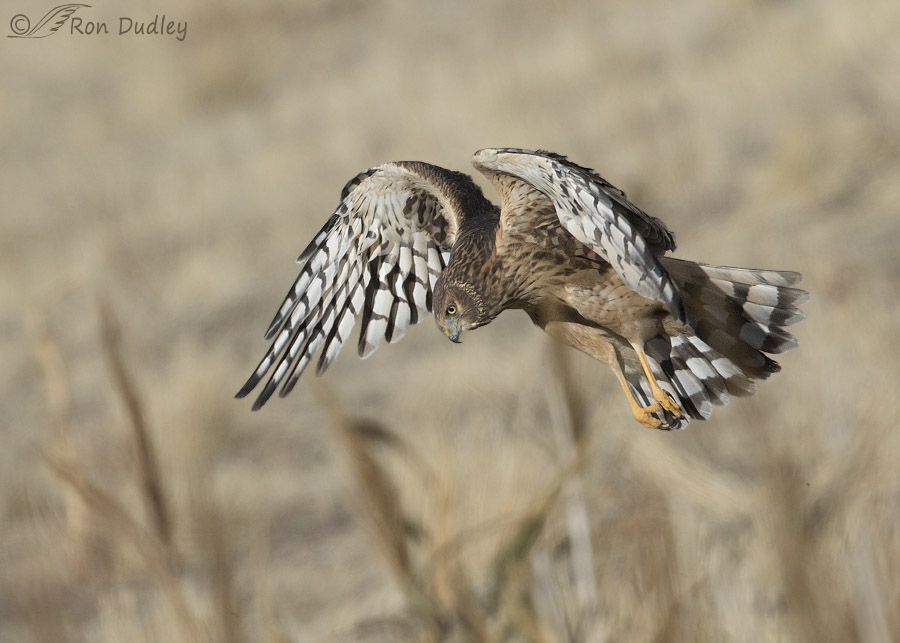Northern Harriers have a hunting technique all their own.
The following three photos are sequential shots of the same hunting harrier.

1/5000, f/6.3, ISO 500, Canon 7D Mark II, Canon EF 500mm f/4L IS II USM + EF 1.4 III Extender, not baited, set up or called in
I photographed this Northern Harrier two days ago at Farmington Bay WMA. This was a case where I was familiar with this particular bird’s hunting habits and I predicted its flight path so I had positioned my pickup to get the shots when I saw the bird following the curved road, just like happened in this previous post from a few days earlier. I’m fairly certain it’s the same harrier in both posts.
Harriers virtually always hunt on the wing (usually from less than 15′ off the ground) rather than from perches like Red-tailed Hawks and other buteos often do. Their very light bodies allow them a buoyant, gliding flight with relatively few wing flaps. Most prey pursuits are short and close to the ground. They often use the cover of vegetation and terrain to ambush prey.
Typical of harriers this bird was looking for prey almost straight down most of the time but this shots shows better eye contact.

This photo, taken almost immediately after the previous one, shows how quickly a harrier can react to potential prey below it. I never see other hawks in such an extreme hovering posture as this. The entire body of the bird is hanging down from its wings with its talons in position to penetrate the deep brush and snatch the prey when and if the bird drops down.

1/6400, f/6.3, ISO 500, Canon 7D Mark II, Canon EF 500mm f/4L IS II USM + EF 1.4 III Extender, not baited, set up or called in
Once potential prey has been spotted below them they use one of four types of pounces as described by researchers. This posture precedes the “hover pounce” where they hover over the prey (in my area it’s usually a vole) for 1-3 seconds before quickly dropping on it. This harrier obviously has its eyes glued to something down there but this time it didn’t make an actual attempt at catching it and soon went on its way.
I like this photo for a variety of reasons and one of them is actually related to an aesthetic shortcoming – that stalk of out of focus vegetation poking up into the bird’s lower breast. It’s common for harriers to hover this low but I rarely see good photos of it because the vegetation sticking up into the frame usually grabs onto the camera’s active focus points and causes the harrier to be very soft.
So I like this photo partially because it shows typical harrier behavior – hunting so slow and low to the ground that they’re actually almost engulfed by part of the vegetation directly below them.
Ron


Ron, you have such talent to capture photos such as these. The Northern Harrier is an intriguing bird and the 2nd and 3rd photos certainly capture something that most of us would never see. Thank you for the photos, Ron.
I’m glad you liked them, Alice. Thank you.
Do you often get home and while reviewing your photos find yourself uttering out loud “damn stick!”?
Love the second photo.
Ha, I don’t typically wait until I get home. I usually see it in my viewfinder in the field. And the term I use is usually worse than just “damn”, too. Though you’re right, April. There are times when I don’t see the stick until I get the image on the big screen – especially when it’s out of focus and in front of the bird.
Wowsers. Am I right in thinking that they make ‘turn on a dime’ seem sadly unambitious?
You sure are, to extreme, EC. They’re incredibly agile and quick. That particular maneuver when their pounce is “preceded by a sharp 270° turn with a very short radius” is so unique it has it’s own name – the “hook pounce”. It’s a jaw-dropping maneuver and very effective at grabbing quick, small prey.
Tenacity and perseverance are your attributes Ron! Great shots, I can never seem to get close enough with my lens to even come close to taking these type of shots.
I love watching them hunt with Bins from afar.
They truly are a difficult bird to approach, Dick. They avoided me for hours today.
Once this morning when I tried to maneuver my pickup for a potential shot of a harrier in flight if it came in close enough but veered away at a great distance I asked Mia rhetorically “Why do I even try?” Then I immediately answered myself out loud by saying “Because once in 300 times it actually works with harriers!”. Those odds are actually pretty close to reality…
Wow! That second shot! How do they *do* that?!? The first shot reminds me of a C-17, for some reason. Too bad he didn’t go for it; that would have made quite the shot too!
Marty, If the bird had “gone for it” I’d have lost the bird in the vegetation. But it would have been fun to try to get it in flight with the vole if it wasn’t just eaten in place – that can go either way with harriers.
Ron: Thank you as always for the great photos as well as the behavioral information. Ever photograph a Kestrel? Approximately similar behavior at times. Hovering higher. Love these birds!
Richard, yes I’ve photographed kestrels many, many times including when they’re hovering. Lots of raptors will hover but they typically don’t do it low to the ground or have the other style characteristics of hunting harriers.
I really like the unusual poses in the last two photos. Last New Years Day I got to watch a female Harrier hunt, but didn’t realize then that the hunting was while she was flying. I will be wiser next time I see the behavior. Thanks for the education.
Thanks, Susan. “Wiser” is always a good thing!
Thanks for the fantastic photos once again!
Thank you, Joanne.
From what I’ve seen of these birds, I’s add sweep so it would be sweep, hover, pounce….The ones I’ve seen, sweep back and forth, fairly low to the ground, scoping out the area for prey, them suddenly swoop and nab some happless critter….usually a vole or a mouse. Wonderful, illustrative images, especially the the last two.
Thank you, Patty. Researchers call their four types of pouncing styles “hook pounce, hover pounce, straight pounce and slow pounce”.
Northern harriers are my absolute favorite!!! So excited to read your post and see these beautiful pics this morning. They are just spectacular creatures, unlike any other bird of prey (in my humble opinion ). Thanks for sharing, Ron!
). Thanks for sharing, Ron!
You’re right, Emily – they ARE unlike any other raptor in several ways. Including their hunting style and their modified facial disk.
Outstanding, Ron!
Thank you, Jerry.
I love these images. I watch hunting harriers with a true sense of awe.
As do I, Sharon.
Beautiful! They certainly can change position in a heart beat! The last 2 photo’s REALLY show the barring on the underside of the wings……:)
Judy, I noticed that too. They’re like chameleons in a way because their overall color can change dramatically (once you get a look beneath their wings and tail).
Fabulous series Ron!
Charlotte
Thanks, Charlotte.